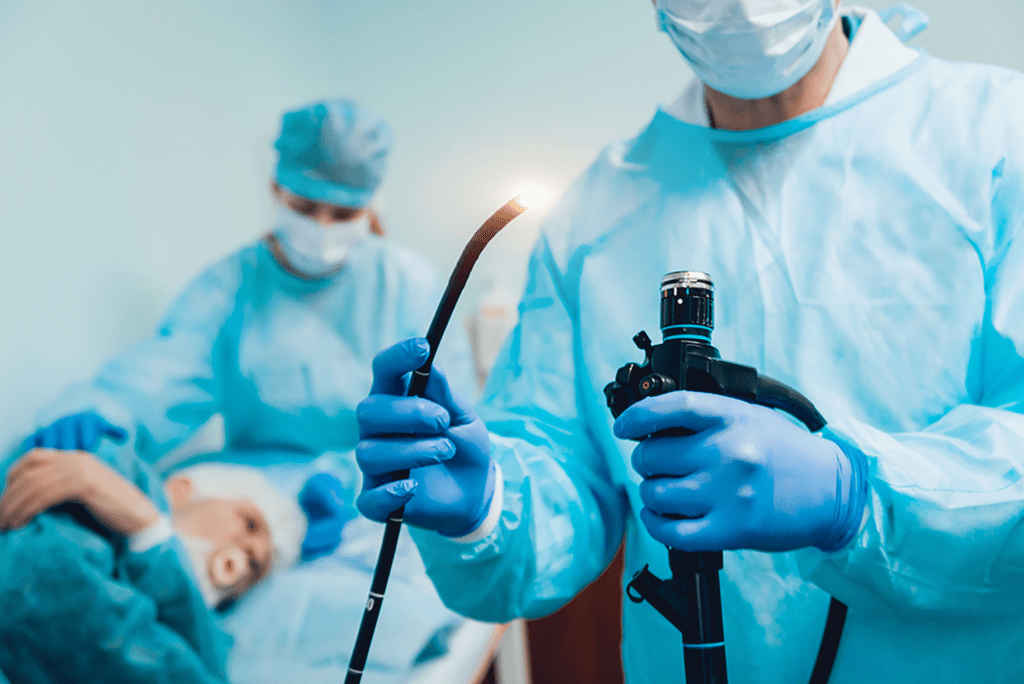
Upper Gastrointestinal Endoscopy
An upper gastrointestinal (GI) endoscopy, also known as an esophagogastroduodenoscopy (EGD), is a common diagnostic procedure performed to assess the oropharynx, esophagus, stomach, and proximal duodenum for dysfunction and disease. The procedure involves introducing an endoscope into the mouth of the patient, advancing the scope down through the esophagus to the duodenum, and visualizing anatomical landmarks before withdrawal. Evaluation of dysphagia, celiac disease, upper GI bleeding, peptic ulcer disease, esophageal strictures, and other indications can be diagnosed from an EGD1, based on findings from written documentation, photodocumentation, or mucosal biopsy collected during the procedure2. Additionally, therapeutic EGD is widely considered the primary treatment for upper GI bleeding and dilation of benign and malignant strictures3. Interventions include polyp removal, percutaneous endoscopic gastrostomy (PEG) tube insertion, stricture dilation, variceal ablation, endoscopic mucosal resection, photodynamic therapy and hemostasis, when appropriate.
Technical Endoscopic Skills Requirements
Clinical competency in EGD requires achieving an acceptable level of cognitive and technical proficiency in several areas. Technical or procedural skills are assessed by demonstration of proper endoscope tip manipulation and control, hand-eye coordination, and landmark and lesion identification, in addition to mastery of diagnostic and standard therapeutic interventions3. Minimum goals for EGD performance include successful intubation of the esophagus and pylorus in over 95% of examinations and intubation of the second part of the duodenum in all cases3. Retroflexed visualization of the gastric fundus and cardia, biopsy sampling, and thorough mucosal inspection are also key skills3. At present, objective evaluation instruments, such as the American Society for Gastrointestinal Endoscopy (ASGE) Assessment of Competency in Endoscopy (ACE) EGD tool, are used to qualify competent trainees.
Since technical competency for EGD is defined as a 90% success rate or by completion of a set number of procedures prior to assessment, these quantitative measures have been used as indicators for experience. The ASGE recommends a minimum of 130 EGD procedures—25 of which should be for the treatment of nonvariceal hemorrhage and 20 for the treatment of variceal hemorrhage—before evaluation of a trainee’s competency3. Current Canadian credentialing guidelines recommend the completion of 150 procedures (at least 100 performed without assistance) before assessment3. These guidelines, developed by the Canadian Association of Gastroenterology (CAG), endorse 20 additional procedures each for advanced or invasive EGD interventions, such as management of nonvariceal and variceal hemorrhage esophageal guide wire dilation, and PEG tube placement. Although case completions can be used to numerically quantify experience, a supplementary record of unassisted and successful procedure completions, interventions used, and complications encountered should be considered for more meaningful evaluations of resident skill. Notably, an online survey distributed by the CAGS Residents Committee to Canadian general surgery residents reported that 84% (389/463) of respondents did not meet minimum EGD procedure numbers set by the ASGE4. Moreover, 22% (102/463) of respondents reported no experience completing an EGD as the primary endoscopist4, highlighting a significant gap in current training.
Training for Competency with Virtual Reality Simulators
Increasingly, as technical aspects of gastroenterology become more complex and gaps in standard 2-year Gastroenterology residency programs or 4-12 week General Surgery endoscopy training blocks are identified, the use case for virtual reality (VR) endoscopy simulators as an alternative training approach to attaining competency is growing. VR surgical training simulators, such as Intelligent Haptronic Solutions’ (IHS) VR endoscopy simulator, recreate the clinical experience for residents and trainees to acquire surgical skills in the absence of real patients. Unlike conventional patient-based training in residency programs, learners build their experience by practicing endoscopic procedures in a low-risk, controlled virtual environment. A number of studies have shown the benefits of this simulation-based training (SBT) model on clinical performance in EGD procedures compared with no SBT5. Whereas certain cases and patient types may never be encountered in the clinical setting, a well-designed VR surgical simulator provides trainees with the opportunity to complete a breadth of basic and advanced procedures on customizable virtual patient types. For example, IHS’ VR endoscopy simulator supports a range of diagnostic and therapeutic EGD tasks for learners to familiarize themselves with. Additional features such as customized patient cases and objective measures of performance built within IHS’ VR endoscopy simulator can confer further benefits as a competency assessment tool for credentialing applications.
As advancements in endoscopic techniques and best practices progress, new learning strategies are warranted to equip residents and trainees with the skills and experience in EGD and other procedures. IHS’ VR endoscopy simulator addresses gaps in current patient-based training in Gastroenterology and General Surgery residency programs and facilitates the attainment of technical competency.
- American Society for Gastrointestinal Endoscopy and American College of Gastroenterology. (2015). Quality indicators for EGD. Gastrointest Endosc, 81, 17-30.
- Ponich, T., Enns, R., Romagnuolo, J., Springer, J., Armstrong, D., & Barkun, A.N. (2008). Can J Gastroenterol, 22(4), 349-354.
- Cohen, J., Safdi, M.A., Deal, S.E., Baron, T.H., Chak, A., …& Pike, I.M. (2006). Gastrointest Endosc, 63, S10-15.
- Switzer, N., Dixon, E., Tinmouth, J., Bradley, N., Vassiliou, M., … & de Gara, C. (2015). Endoscopy in Canada: Proceedings of the National Round Table. Can J Gastroenterol Hepatol, 29(5), 259-265.
- Di Giulio, E., Fregonese, D., Casetti, T., Cestari, R., D’Ambra, G., …& Delle Fave, F. (2004). Training with a computer-based simulator achieves basic manual skills required for upper endoscopy: a randomized controlled trial. Gastrointet Endosc, 60(2), 196-200.
To learn more about features of Intelligent Haptronic Solutions’ VR digestive endoscopy simulator, visit the product page or get in touch with the team.